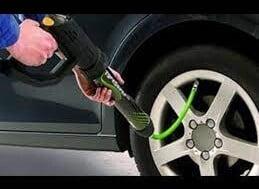all english artical in end
السيارات الكهربائية قادمة THE EVs ARE COMING
من Ford و GM إلى الشركات الناشئة مثل Rivian ، تحدى كبير من من الجميع لتحدي Tesla من أجل مستقبل يعمل بالبطارية.
كانت نيسان ليف فرصة للنجاح. شيفروليه بولت لا يمكن تجاهلها. Audi e-tron وهي سيارة كهربائية من شأنها أن تُظهر لـ Tesla ما يمكن أن يفعله الكبار. مبكراً تم الإشادة بهذه النماذج الكهربائية باعتبارها تغير قواعد اللعبة.
شهدت السيارات الكهربائية نجاحًا صعبًا في الولايات المتحدة ، كانت The Leaf ، واحدة من أكثر السيارات الكهربائية غير Tesla شعبية للبيع ، أفضل عام لها في 2014 ، باعت 30200 سيارة. (حيث باعت نيسان أكثر من 400 ألف سيارة هنا في كل من 2017 و 2018). حتى مع قيام تسلا ، حيث بيعت ما يقدر بـ 223.200 سيارة العام الماضي ، انخفضت مبيعات السيارات الكهربائية نسبياً في الولايات المتحدة عن مستويات 2018. وبصرف النظر عن Tesla ، لم تحقق أي شركة سيارات أخرى نجاحًا حقيقيًا للسيارات الكهربائية ، على الرغم من عقد من المحاولات.
ومع ذلك لم يضعف الحماس. يبدو صانعو السيارات أكثر جرأة ، حيث يجهزون بعدد غير مسبوق من الداخلين إلى هذا المجال في العقد المقبل. طبقا لتقارير شركة أبحاث السوق AutoPacific ما بين 90 إلى 100 معرضاً جديد في الولايات المتحدة بحلول عام 2030.
والمبالغ التي يضعها صانعو السيارات لتحقيق ذلك خطيرة. أعلنت جنرال موتورز أنها تستثمر 20 مليار دولار لإنتاج 20 موديلات جديدة بحلول عام 2023 ، بما في ذلك سيارة جي إم سي هامر الكهربائية المعاد تصورها. تعلق فورد شارة موستانج الأيقونية على سيارة Mach-E الكهربائية كجزء من التزام بقيمة 11 مليار دولار لتصنيع السيارات الكهربائية تم الإعلان عنه في عام 2018. وفي العام الماضي ، تعهدت مجموعة فولكس فاجن بتقديم 91 مليار دولار لقضية السيارات الكهربائية.
إذن ما الذي يغذي هذه الموجة من الاستثمار في مستقبل كهربائي في مواجهة المبيعات المضطربة؟ يتعين على شركات صناعة السيارات الالتزام بلوائح الانبعاثات الأكثر صرامة. لقد ذهبت المملكة المتحدة إلى حد تحديد عام 2035 باعتباره العام الذي ستحظر فيه بيع المركبات الجديدة ذات محركات الاحتراق الداخلي ، بما في ذلك السيارات الهجينة.
لا تمثل الولايات المتحدة سوى جزء بسيط من عالم شراء السيارات الكهربائية. في عام 2019 ، كان سوق السيارات في الصين أكبر بنحو 50 في المائة، واشترى المستهلكون في ذلك البلد ثلاثة أضعاف ونصف عدد السيارات الكهربائية التي يشترى الناس.
وحتى إذا لم تكن الولايات المتحدة شديدة الاهتمام بالمركبات الكهربائية في الوقت الحالي ، فمن المهم أن تتذكر أن العديد من هذه المركبات والتقنيات يتم تطويرها للأسواق العالمية.
في الصين ، أكبر سوق لصناعة السيارات ، تراجعت مبيعات الاحتراق الداخلي بنسبة 8.4٪ العام الماضي ، بينما انخفضت مبيعات السيارات الموصولة بالكهرباء بمقدار 4٪ ، وهو ما يُترجم إلى زيادة في حصة سوق السيارات الكهربائية.
وعدت ماري بارا ، الرئيس التنفيذي لشركة جنرال موتورز ، بأن “المستقبل الكهربائي بالكامل” الذي تخطط له الشركة سيشهد مليون مركبة كهربائية سنويًا في الولايات المتحدة والصين بحلول 2025. هذا هدف نبيل بالنظر إلى أنه يتحرك الآن 112000 فقط ، لكن Wuling Hongguang Mini EV التابعة لجنرال موتورز تصدرت مبيعات 15000 في أغسطس ، لتصبح EV الأكثر شعبية في الصين.
تتوقع AutoPacific أن تتضاعف حصة سوق السيارات الكهربائية في الولايات المتحدة ثلاث مرات بحلول عام 2025.
تكثر التهديدات الأخرى ، ليس أقلها قدرة وباء كورونا على تدمير مبيعات السيارات ، وتأخير إطلاقها ، وتهديد الشركات الناشئة الهشة ، والحفاظ على أسعار البنزين بأسعار منخفضة. قد يجد المستهلكون المصابون بالصدمة سبباً أقل للقيام برحلة على سيارة كهربائية باهظة الثمن.
معظم السيارات الكهربائية في الولايات المتحدة لديها مبيعات ليست كبيرة. ولكن عندما قدمت Tesla أخيرًا إنتاج Model 3 في عام 2018 ، أثبتت أن المركبات الكهربائية ليست غير مرغوب فيها بطبيعتها. كانت السيارة ذات السوق الضخم واحدة من أفضل سيارات الركاب مبيعًا لعام 2019.
إذا رفض الأمريكيون حتى الشاحنات الكهربائية ، فماذا بعد؟ يقول العديد من المحللين إن مصنعي المعدات الأصلية سوف يتراجعون ببساطة لأنه لا عودة إلى الوراء. لا تقوم جنرال موتورز و LG Chem ببناء مصنع للبطاريات بقيمة 2.3 مليار دولار في أوهايو لمجرد إيقاف تشغيله في غضون بضع سنوات. الجانب الإيجابي لشركات صناعة السيارات الراسخة هو أن ليس لديهم مجال للفشل ، لا يزال لدى الشركات العالمية العملاقة مساهمون لإرضائهم ، لكنهم أحرار في تطوير سيارات ذات مفهوم ، يقول بيترسون من AutoPacific:
“Once you’ve got the platform, it’s not that expensive to put new top hats on it,”.
ستصبح عملية البناء أسهل مع الوقت والابتكار. في عام 2017 ، قدر المحللون أن جنرال موتورز خسرت حوالي 7000 دولار على كل سيارة بولت جديدة تم بيعها في ذلك العام. ولكن من خلال الشراكة مع LG Chem ، تقول جنرال موتورز إن أسعار خلايا بطارية Ultium ستنخفض إلى أقل من 100 دولار لكل كيلوواط / ساعة وستسمح للشركة بجني أرباح من السيارات الكهربائية في المستقبل.
من المفيد التفكير في هذا كله على أنه مرحلة استثمار ، حيث يقوم صانعو السيارات بصب استثمارات في مؤسسات كهربائية. تبدو بلا نهاية ومليئة بالمخاطر. ولكن مع وجود ما يكفي من الوقت والمال والإيمان ، فسوف يمتلكون شركات أكثر ذكاءً وقوة لتتحمل العواصف الاقتصادية المستقبلية.
THE EVs ARE COMING
From Ford and GM to startups like Rivian, a big challenge from everyone to challenge Tesla for a battery-powered future.
The Nissan Leaf was an opportunity to succeed. Chevrolet Bolt can not be ignored. The Audi e-tron is an electric car that will show Tesla what adults can do. Early on, these electric models were hailed as a game changer.
Electric cars have had a hard hit in the US The Leaf, one of the most popular non-Tesla electric cars for sale, had its best year in 2014, selling 30,200 vehicles. (Nissan sold more than 400,000 cars here in both 2017 and 2018). Even with Tesla, where an estimated 223,200 vehicles were sold last year, sales of electric vehicles in the United States are relatively down from 2018 levels. Aside from Tesla, no other car company has had real success with electric vehicles, despite a decade of attempts.
However, the enthusiasm did not wane. Automakers are looking even bolder, arming an unprecedented number of entrants into the field in the next decade. According to market research firm AutoPacific, there will be 90 to 100 new showrooms in the United States by 2030.
And the sums that automakers are putting into this are dangerous. General Motors has announced that it is investing $20 billion to produce 20 new models by 2023, including the reimagined electric GMC Hummer. Ford attaches the iconic Mustang badge to the electric Mach-E as part of an $11 billion commitment to make electric vehicles announced in 2018. Last year, the Volkswagen Group pledged $91 billion to the cause of electric vehicles.
So what is fueling this wave of investment in an electric future in the face of turbulent sales? Automakers have to adhere to stricter emissions regulations. The UK has gone so far as to set 2035 as the year it will ban the sale of new internal combustion engine vehicles, including hybrids.
The United States is only a small part of the electric car buying world. In 2019, China’s auto market was about 50 percent larger, and consumers in that country bought three and a half times as many electric cars as people.
Even if the United States is not very interested in electric vehicles at the moment, it is important to remember that many of these vehicles and technologies are being developed for global markets.
In China, the auto industry’s largest market, sales of internal combustion fell 8.4% last year, while sales of plug-in cars fell by 4%, which translates to an increase in the electric car market share.
GM CEO Mary Barra has promised that the company’s plans for an “all-electric future” will see 1 million electric vehicles a year in the US and China by 2025. That’s a lofty goal considering it’s only 112,000 now moving, but GM’s Wuling Hongguang Mini EV Motors topped sales of 15,000 in August, becoming the most popular EV in China.
AutoPacific expects the US electric vehicle market share to triple by 2025.
Other threats abound, not least the ability of the Corona epidemic to destroy car sales, delay their launch, threaten fragile start-ups, and keep gasoline prices low. Shocked consumers may find less reason to take a trip on an expensive electric vehicle.
Most electric cars in the United States have not great sales. But when Tesla finally introduced Model 3 production in 2018, it proved that electric vehicles aren’t inherently undesirable. The mass-market vehicle was one of the best selling passenger cars of 2019.
If Americans refuse even electric trucks, then what? Many analysts say OEMs will simply hold back because there is no turning back. General Motors and LG Chem aren’t building a $2.3 billion battery plant in Ohio just to shut it down in a few years. The upside for established automakers is that they have no room for failure, the global giants still have shareholders to please them, but they are free to develop concept cars, says Peterson of AutoPacific:
“Once you’ve got the platform, it’s not that expensive to put new top hats on it,”.
The building process will get easier with time and innovation. In 2017, analysts estimated that General Motors lost about $7,000 on every new Bolt sold that year. But by partnering with LG Chem, GM says prices for Ultium battery cells will drop to less than $100 per kilowatt-hour and allow the company to reap profits from electric vehicles in the future.
It is useful to think of all this as an investment phase, as automakers pour investments into electrical enterprises. It seems endless and full of dangers. But with enough time, money, and faith, they will have smarter, stronger companies to withstand future economic storms.
From Ford and GM to startups like Rivian, a big challenge from everyone to challenge Tesla for a battery-powered future.
The Nissan Leaf was an opportunity to succeed. Chevrolet Bolt can not be ignored. The Audi e-tron is an electric car that will show Tesla what adults can do. Early on, these electric models were hailed as a game changer.
Electric cars have had a hard hit in the US The Leaf, one of the most popular non-Tesla electric cars for sale, had its best year in 2014, selling 30,200 vehicles. (Nissan sold more than 400,000 cars here in both 2017 and 2018). Even with Tesla, where an estimated 223,200 vehicles were sold last year, sales of electric vehicles in the United States are relatively down from 2018 levels. Aside from Tesla, no other car company has had real success with electric vehicles, despite a decade of attempts.
However, the enthusiasm did not wane. Automakers are looking even bolder, arming an unprecedented number of entrants into the field in the next decade. According to market research firm AutoPacific, there will be 90 to 100 new showrooms in the United States by 2030.
And the sums that automakers are putting into this are dangerous. General Motors has announced that it is investing $20 billion to produce 20 new models by 2023, including the reimagined electric GMC Hummer. Ford attaches the iconic Mustang badge to the electric Mach-E as part of an $11 billion commitment to make electric vehicles announced in 2018. Last year, the Volkswagen Group pledged $91 billion to the cause of electric vehicles.
So what is fueling this wave of investment in an electric future in the face of turbulent sales? Automakers have to adhere to stricter emissions regulations. The UK has gone so far as to set 2035 as the year it will ban the sale of new internal combustion engine vehicles, including hybrids.
The United States is only a small part of the electric car buying world. In 2019, China’s auto market was about 50 percent larger, and consumers in that country bought three and a half times as many electric cars as people.
Even if the United States is not very interested in electric vehicles at the moment, it is important to remember that many of these vehicles and technologies are being developed for global markets.
In China, the auto industry’s largest market, sales of internal combustion fell 8.4% last year, while sales of plug-in cars fell by 4%, which translates to an increase in the electric car market share.
GM CEO Mary Barra has promised that the company’s plans for an “all-electric future” will see 1 million electric vehicles a year in the US and China by 2025. That’s a lofty goal considering it’s only 112,000 now moving, but GM’s Wuling Hongguang Mini EV Motors topped sales of 15,000 in August, becoming the most popular EV in China.
AutoPacific expects the US electric vehicle market share to triple by 2025.
Other threats abound, not least the ability of the Corona epidemic to destroy car sales, delay their launch, threaten fragile start-ups, and keep gasoline prices low. Shocked consumers may find less reason to take a trip on an expensive electric vehicle.
Most electric cars in the United States have not great sales. But when Tesla finally introduced Model 3 production in 2018, it proved that electric vehicles aren’t inherently undesirable. The mass-market vehicle was one of the best selling passenger cars of 2019.
If Americans refuse even electric trucks, then what? Many analysts say OEMs will simply hold back because there is no turning back. General Motors and LG Chem aren’t building a $2.3 billion battery plant in Ohio just to shut it down in a few years. The upside for established automakers is that they have no room for failure, the global giants still have shareholders to please them, but they are free to develop concept cars, says Peterson of AutoPacific:
“Once you’ve got the platform, it’s not that expensive to put new top hats on it,”.
The building process will get easier with time and innovation. In 2017, analysts estimated that General Motors lost about $7,000 on every new Bolt sold that year. But by partnering with LG Chem, GM says prices for Ultium battery cells will drop to less than $100 per kilowatt-hour and allow the company to reap profits from electric vehicles in the future.
It is useful to think of all this as an investment phase, as automakers pour investments into electrical enterprises. It seems endless and full of dangers. But with enough time, money, and faith, they will have smarter, stronger companies to withstand future economic storms.






